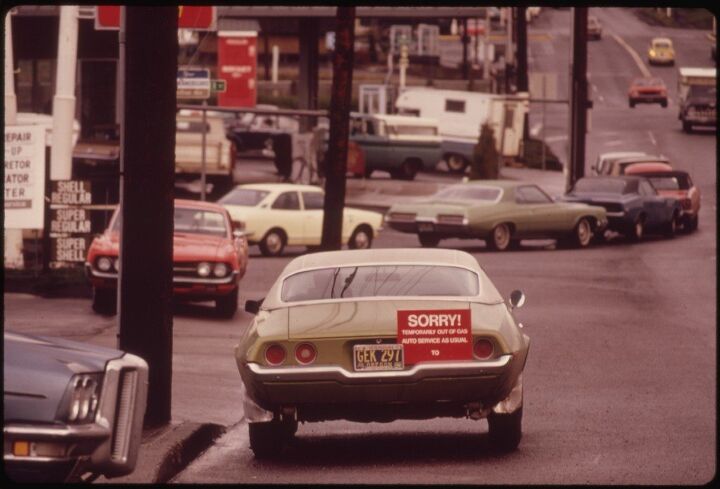The 1973 Oil Crisis: 40 Years Later
Forty years ago this month, the Organization of Arab Petroleum Exporting Countries (consisting of OPEC’s Arab members plus Egypt, Syria and Tunisia) began an oil embargo that would last through March of 1974.
The cause of the embargo: Intervention. During the Yom Kippur War between Egypt and Syria versus Israel, other Arab nations had lent their support to their brothers in northern Africa (as well as the Soviet Union, who supplied weapons). In turn, the United States helped their ally (who had gone on full nuclear alert) by supplying arms and other goods through President Richard Nixon’s authorization of Operation Nickle Grass. This prompted OAPEC to respond by beginning an oil embargo whose effects still linger to this day.
In the United States — the main target of the embargo –this led to long lines at the pumps during the weekdays (after a suggestion by Nixon that gas station owners voluntarily not sell fuel on Saturday night and Sunday; 90 percent complied with the suggestion), odd-even fuel rationing, three-color flag systems denoting availability (or lack thereof) of any fuel, and the passing of the Emergency Highway Energy Conservation Act, better known as the act that would set the national speed limit at 55 mph for the next two decades.
Though the first oil crisis would end when OAPEC accepted the promise of a settlement negotiated between Syria and Israel through the United States, the effects of the five-month-long embargo would linger for the rest of the decade and beyond.
Prior to the embargo, the most popular cars sold were large and in charge with big V8s to pull them along the highway. After the shock, however, most motorists sought out smaller, more fuel efficient offerings from Europe and Japan. The shock also gave birth to compact trucks, such as the Chevrolet LUV and Toyota Hilux, and prompted the Big Three to offer their own import fighters prior to downsizing their entire lineup of cars by the end of the 1970s, and the switch to front-wheel drive that would come to dominate the 1980s.
The shock also affected motorsports, with the cancellation of both the 24 Hours of Daytona and the 12 Hours of Sebring in 1974, and NASCAR reducing all race distances by 10 percent.
And of course, the 1973 oil crisis set off the movement to find as many energy sources as possible (and ways to conserve said energy) to reduce if not outright eliminate dependence on foreign oil, as any Albertan or North Dakotan could explain in detail today to anyone who will listen.
Photo credit: David Falconer/U.S. National Archives and Records Administration/ Wikimedia Commons/ CC PDM 1.0
Seattle-based writer, blogger, and photographer for many a publication. Born in Louisville. Raised in Kansas. Where I lay my head is home.
More by Cameron Aubernon
Latest Car Reviews
Read moreLatest Product Reviews
Read moreRecent Comments
- SCE to AUX Norway is in Europe, and Tesla is an American automaker - no problems there.I wouldn't use Ford as the bellwether.https://www.reuters.com/business/autos-transportation/tesla-extends-lead-norway-evs-take-record-82-market-share-2024-01-02/https://elbil.no/english/norwegian-ev-policy/
- Steve Biro If the U.S. government wants to talk about banning all connected cars - or at least the collection and sharing of information from said vehicles - I’m all ears. Otherwise, don’t waste my time.
- Ajla Both parties are in favor of banning Chinese vehicles so I don't see how it won't happen in the next year.
- Add Lightness I don't waste a lot of time watching nothing much happening by watching the YouTube 6 minute highlights.
- MrIcky from my rental fleet experience, id rather drive one of these than a camry.


































Comments
Join the conversation
Since 1973, the population of the world has doubled. Global oil consumption has almost tripled. OPEC has added members. Yet, OPEC produces about the same number of barrels of oil today is they did 40 years ago. Wonder why that would be? Even today, the U.S. is producing more oil than at any time in recent history. Why has the price of oil not come down? Surely domestic producers aren't charging their fellow citizens based on the global price of oil? Wouldn't that be unpatriotic? Certainly domestic oil company shareholders wouldn't object if their company softened the fuel price burden on their fellow citizens, right? I thought "Drill Baby Drill" was supposed to help oil and fuel prices. Certainly, the Keystone Pipeline will lower prices, right? Isn't that what the API and the Canadian company that wants to build the pipeline through the center of our country want us to believe. We've been drilling like crazy. We've been producing like crazy. Where is the price relief we were promised? We are currently exporting a LOT of refined fuels. How can that be? I thought added supply is supposed to bring prices down. We have so much we are exporting the stuff while prices at the pump remain high? Has someone lied to us?
One thing I remember about the 1973 " oil crisis " was the Nixon administration decree adopting daylight savings time for the whole year . Many people up north were upset with the idea of schoolkids waiting for the bus in the dark . Not as big of a concern down south but I was in college in 1973 and recall taking a class that began at IIRC 7:00 in the morning and it would remain dark for the whole class .And my mother encouraged me to travel to the Grand Canyon , Utah , etc. during Spring and Fall break - there was really a widespread fear that in the future gas would be either very expensive or unobtainable and travelling by car to faraway destinations would be impossible .